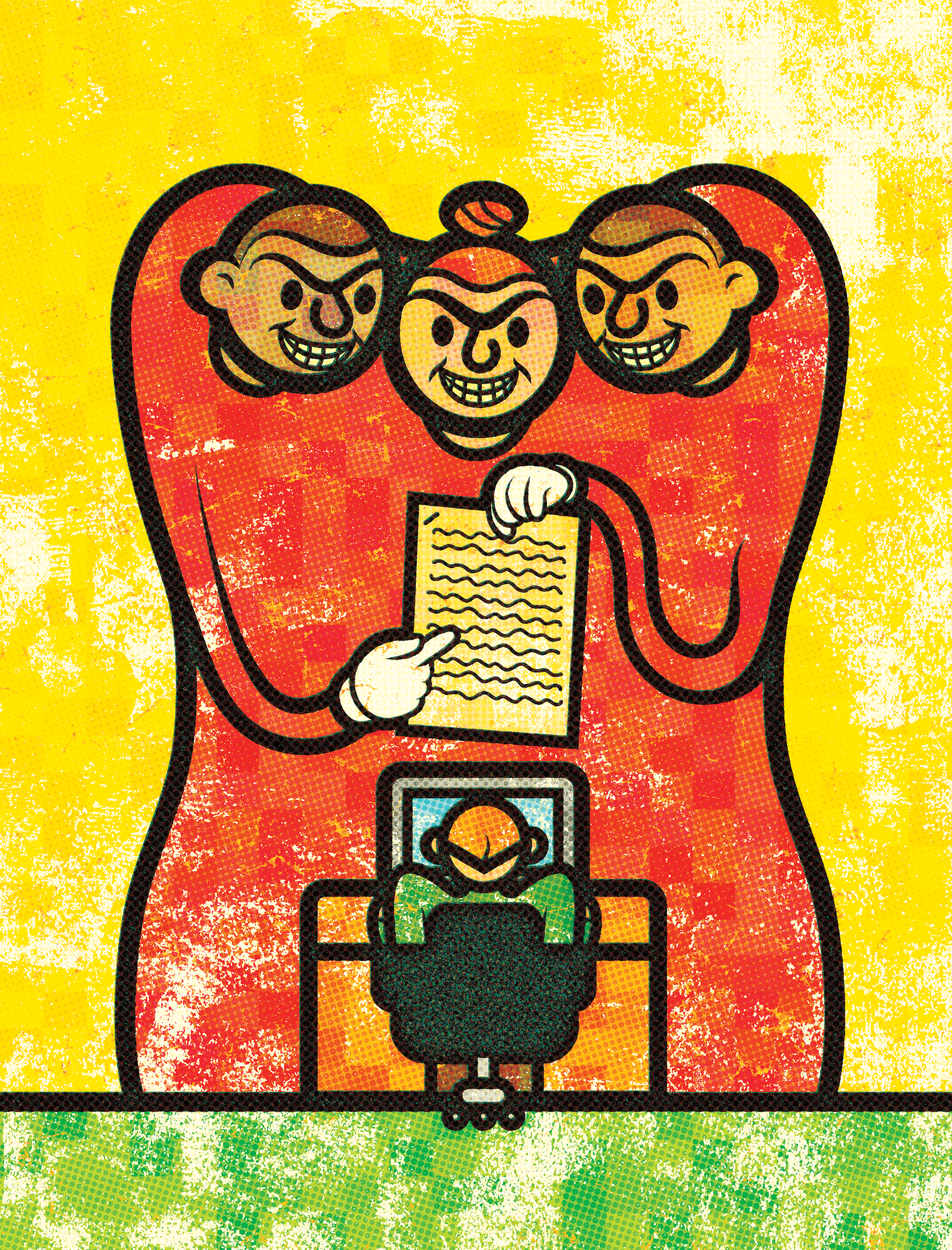Inside the strange symbiosis of journalism and public relations

Illustration by Alexei Vella
In October 2022, Loblaw Companies Ltd., which operates 2,400 grocery stores and pharmacies across Canada, including Loblaws, No Frills, Real Canadian Superstore, Zehrs, and Shoppers Drug Mart, announced its intention to freeze prices on more than 1,500 of its No Name-brand products until the end of January 2023. A promotional email to customers, signed by chairman and president Galen Weston, said that the price of an average basket of groceries had gone up 10 percent in 2022 and almost 15 percent over the last two years. Weston told customers these increases were “maddeningly” out of the company’s control, blaming suppliers for passing along rising costs. The price freeze on No Name products, already 25 percent cheaper than comparable brand-name groceries, “could make a real difference in both your grocery bills and your peace of mind,” said the email. By end of day, major media outlets, including The Globe and Mail, the Toronto Star, Global News, and CBC, had regurgitated the email as news. Loblaw had successfully disseminated its corporate messaging through the media.
The strategic messaging didn’t fool every journalist, though. In an op-ed for the Star, Jim Stanford, director of Vancouver’s Centre for Future Work, wrote, “The public relations flacks at Loblaws must have figured they had a winning idea….It’s no coincidence this happened the same day the House of Commons voted on an NDP motion to investigate the extent to which supermarket profits have contributed to higher grocery prices.”
Indeed, the NDP’s motion denounced the “massive profits” that major grocery chains had made over the previous year while the cost of groceries soared. It called on the government to close tax loopholes and force CEOs and large corporations to pay what they owe. It asked for a Competition Bureau investigation into grocery chain profits and to support a House committee study asking grocery bosses to testify about the role of “greedflation.” With the motion garnering unanimous support from MPs, it’s easy to see why Loblaw may have wanted to shift the narrative.
The Loblaw incident highlights the way public relations professionals spread corporate messaging through journalists. Despite the criticism, Loblaw weathered the stormy days following the announcement. Ultimately, it’s hard to call the strategy a failure, given the media attention it generated.
It also put journalists in a tough spot. A price freeze at a major grocery chain is a matter of public interest—even if it’s a publicity ploy. By doing their jobs, journalists unwittingly executed the plans of publicists.
Winning over Journalists
Broadly speaking, PR professionals provide information, access to sources, digital assets, and occasionally products to journalists to assist in their reporting. In many cases, they gate-keep, acting as liaisons between journalists and public figures. The day-to-day work of publicity personnel depends on the company—from beauty brands to world leaders—but the goal is the same: to secure favourable press for clients.
Cision is a communications platform for public relations and marketing professionals. In its annual Global State of the Media Report, it studies the needs of journalists, identifies trends in journalism, and advises PR practitioners on insights they “need to win over journalists.” Focusing on how journalists produce their work, along with their accompanying challenges and frustrations, the 2022 report surveyed 3,800 journalists in 2,160 media outlets worldwide. “The more that you provide relevant and appropriate content up front—with captions and credits,” the report counsels publicists, “the easier you make it for them to cover your story.”
“We have a term for this,” says Josh Greenberg, director of Carleton University’s School of Journalism and Communication, who studies media and the politics of news-making. “It’s called an information subsidy.” The more PR professionals can subsidize the work of journalism, the less work for the journalist or editor. Information subsidies can take the form of prepackaged stories, as when, for example, Heineken introduced its first virtual beer in March 2022, garnering much media attention, including from the BBC, which appeared to directly lift a quote from the brand’s global brand head without citing the press release as the source.
An information subsidy could also mean ensuring ready access to a highly trained or expert source or providing visuals. Journalists know it’s important to attribute the information to a press release and to interrogate the information by seeking other verifying sources, and they know that a press release published verbatim as news would be a major victory for any PR professional. Yet journalism is expensive, says Greenberg, and these subsidies reduce the cost burden of news-making. This is important in an era where the costs of doing journalism are increasing, the return on investment in the form of subscriptions is decreasing, and advertisers are fleeing online to market their products directly to consumers via algorithms.
A press release is a form of targeted marketing intended to be shared. Since PR pros are trained to write copy as inverted-triangle news stories, they’re framing the story for the journalist in advance. According to the Cision report, “For all the changes the media has seen in recent years…press releases are still one of the most powerful vehicles for getting your news, story, product or event in front of the right journalists.”
Greenberg says there are a few variables in determining how much journalists reshape press releases—the amount of time they have, how many other stories they need to write, their level of expertise on the subject, and their overall journalism experience. The expert quotes—carefully crafted with the source—are likely to remain. The journalist might follow up to test the quotes, but sources most likely will have been media trained to deliver variations of those quotes, all driven by key messaging. “Every journalist is against the clock,” says Greenberg, “so if the story is written in such a way that largely looks and feels like a news story, it reduces the amount of work that a journalist assigned to write that story has to have.”
Press Releases Printed Verbatim
Press releases are a PR strategy to garner “earned media,” which differs from advertising because the company does not pay for media placement. Instead, it attempts to convince reporters or editors to write a positive story that appears in the editorial section rather than the paid media section with other advertising messages. Along with messages emanating from traditional sources of publicity, such as print and broadcast, earned media can also include messages on social media platforms and blogs. Earned media is fundamentally different from paid advertising or owned media (media placed on a company’s own platforms). Those media are fully controlled by the firm, whereas earned media, because it is independently verified by a trusted third party—like a journalist—is less controlled. For that reason, earned media has traditionally been considered less biased and more credible.
Public relations departments are using Substack to bypass journalists and speak directly to their audience
Allan Thompson, who heads the journalism program at Carleton, could not believe how easy it was to earn his own media when in 2015 he ran as a federal Liberal candidate for the southwestern Ontario riding of Huron-Bruce. Having put together his own PR and communications during the campaign, “I was astounded by the degree to which I could simply package my material and news organizations would use it,” he says, surmising that the phenomenon speaks to the collapse of community news in rural communities. Local news gatherers don’t always have the capacity they once did to cover events and to critically report and write original stories. While there’s long been a relationship where the PR side created content that journalists processed, the current imbalance between the sides means that more unprocessed PR work appears in the newspaper.
With 20 years of journalism experience before taking on his current role at Carleton, Thompson had a good sense of how to write excellent press releases. “I essentially wrote news stories about my own events,” he says, explaining that he did head counts and recorded his events so that he could include accurate quotes of attendees and write the stories ethically. He generally knew that because of resource and time constraints and journalists’ workloads, it was unlikely a journalist would cover his small-town Ontario events. Still, he was shocked by how often his press releases would appear verbatim as news stories. “A daily newspaper in this country running a news story written by the candidate without any kind of disclaimer,” says Thompson. “I thought, Oh, my God, this is the way it can be.”
Even though it may be easier for PR personnel to get their stories placed in media, this does not mean the age-old fissure between journalism and PR has been mended. As far back as 2003, in a historical analysis for Public Relations Review, Denise DeLorme and Fred Fedler wrote of the rift between journalists and publicists. “For years, journalists have charged that public relations practitioners are unethical, manipulative, one-sided, and deceptive,” serving “special interests rather than the public.” Meanwhile, PR professionals “respond that journalists have a narrow and self-righteous view of their work and know little about public relations, a profession in which ethical conduct is important.”
Not much has changed. Indeed, as researcher and former PR professional Matilda Kolić Stanić notes in her 2020 paper on journalism and PR ethics for Church, Communication and Culture, there are six persistent stereotypes plaguing PR: those who deal in PR inevitably lie; PR professionals are “champions at playing hide and seek”; a PR professional’s thoughts are subservient to the goals of their employer; anyone can work in PR; PR professionals “are faithful only to the institution they work for”; and in PR, social responsibility is “only cosmetics.”
Whether these stereotypes have some basis in truth, communications scholar J. Paulo Serra argued in a 2014 paper discussing the ethics of journalism for the communication sciences journal Comunicação e Sociedade that it is impossible for propaganda—rebranded “less negatively as ‘public relations,’ ‘advertising,’ ‘strategic communication’”—to exist without the media and that relationship has been “very conveniently forgotten.”
What PR Practitioners Say
“I really never thought I was going to leave news,” says Angela Graves, director of communications and outreach at Step Forward, a not-for-profit, anti-poverty organization in Cleveland, Ohio. But after a long period of feeling undervalued in journalism, she decided to explore the job market in communications. Journalists think of PR as the dark side, but she argues that PR storytelling—at least in the nonprofit sector—is “the bright side.” Graves doesn’t view the relationship between journalists and PR professionals as adversarial now that she is in a communications role; rather, she sees the relationship as one of partnership.
“I still get to tell stories, much more positive stories, than I ever have,” she says, explaining that she looks at everything she produces within the agency through a news perspective. That can range from knowing what makes a good story to understanding what media would need to put together a story on Step Forward. However, a great story isn’t always great for the agency. “I see the spin more on my side now than I did in news because I didn’t have an agenda there,” she says. “I was just telling a story. Here, I have to have an agenda.”
Nadia Tchoumi, who, after 17 years in journalism, is now the media relations and communications manager at Union Gospel Mission in Vancouver, calls the animosity between PR professionals and journalists “contrived controversy—I was ignorant of the possibilities because I’d only seen one side.” As a journalist, typically she encountered PR professionals in government and large corporations where the journalistic story was about what was going wrong or looking for accountability. “When you run up against their comms, they are trying to stop the bleed. But you’re trying to get at the wound so there’s this tension, and out of that we draw conclusions about each other.”
Those conclusions began to shift for Tchoumi when she started to do PR for noble causes. “If you’re working for an organization that’s dismantling systemic racism or combating homelessness, it shifts your perspective,” she says. “You encounter people who aren’t trying to control the message, they’re just trying to get the message out there. If you’re on the comms team for the government, nobody’s going to look at that as a noble cause.”
Tchoumi used to get frustrated by how cyclical news could be and how media report the same stories over and over. Tchoumi also operates her own public relations company, New Hope Media, where she feels better equipped to tell “stories of empowerment for Black people and tell stories that are actually leading to change” than she was in journalism. “So much of what the media focuses on when they talk about Black communities is Black pain. But we can talk about progress, we can talk about Black joy, we can talk about innovation.”
PR isn’t the “dark side,” argues one practitioner. It’s the “bright side” that tells positive stories
There are other ways to cross over. After leaving a career reporting at outlets such as CBC, CTV, and Global, Jennifer Singh decided to start her own business—She’s Newsworthy Media—from the ground up. Billing it as a PR agency for women entrepreneurs in service-based businesses, Singh has helped more than 70 women land media for their businesses, including via nearly 300 interviews in the last few years. Likening what she does to a newsroom’s general assignment desk, Singh calls it “journalism with a blend of PR.” Singh recoils when she hears the word “PR” because, as journalists, “We know that PR is concocted, it’s forced, it’s sales-y, and you can’t get to the truth if you’re working with somebody in PR.” Then again, she thinks the idea of selling in journalism isn’t so far-fetched. “If you have ever convinced anybody to do an interview,” she argues, “you are in sales.”
Singh insists that even though she does PR, her work ought not be lumped entirely into the category. Over the course of 12 weeks, she and her team sit down with the client to determine their perspective and the fresh angle the client brings. They then work on drafting a 300-word pitch for broadcast media, which the client sends out in hopes of getting booked. Typically, they land three to five television interviews. “These are human-interest stories that I get to tell,” Singh says. “That’s why I say I don’t do PR. It’s not PR; it’s journalism.”
PR and Journalism: The Interlock
“There is a functionally essential connection that interlocks journalism and public relations together,” says Carleton’s Josh Greenberg. “Both sides depend on the other to do the work.” Several factors, time especially, discipline journalists. “You have a deadline, the story must be written by a certain time, you need to get your pieces together for that story.” And PR people know that. One way they capitalize on that knowledge is to strategically time the release of information—because the less time journalists have to fact-check and suss out competing positions, the more likely the issue will be covered in a way that aligns with the company’s interests.
Historically, PR has needed news organizations to provide the oxygen for publicity and public legitimacy. Greenberg thinks this structure has been changing in the last decade. “If the public can and does get all of its news and information directly online, then it doesn’t really need the journalist,” he says, “or don’t need them as much as they did in the past.”
Journalist Julia-Simone Rutgers reported on a notable example of this decoupling for The Walrus in October 2022. In her article “Cops on Substack: How Police Are Using Public Relations to Combat Criticism,” Rutgers described an “existential crisis” in policing with respect to how forces communicate with the public. Police communications departments staffed with media professionals and public information officers are a relatively new phenomenon, gaining steam only within the last five to 10 years, with external PR firms being consulted in the crisis stage. In March 2022, the Winnipeg Police Service announced that it had published two articles in a new newsletter called “Tried and True” on Substack, a subscription-based publishing platform. Both sent to subscribers and available on the public Substack page, the stories covered a wide range of topics and were written by police service members selected by either chief Danny Smyth or his chief of staff. As Smyth told Rutgers, the newsletter is a way to “tell our story from a police perspective.”
Critics maintained that the move to Substack offered a biased take on police tactics, editorializing law-enforcement work, and shaping public opinion in favour of the police by, as the Winnipeg Free Press put it, “skirting traditional mechanisms of accountability.” However, Rutgers points out, most articles failed to address the common journalistic practice “of unquestioningly relying on police reports as an ‘official source’ during breaking news events.” She quotes professor of journalism Danielle K. Brown, who wrote in The Conversation that this “gives police an opportunity to shape the initial version of the event—and…gets their version of the story into the public consciousness before victims, families, and their supporters are able to.”
Substack isn’t the only platform that communications departments are using to bypass journalists and speak directly to their audience. In the 2022 edition of the Review of Journalism, Geena Mortfield broke down how governments in nearly a dozen Canadian municipalities produce podcasts to control their narratives, or, as one city official told her, “get our positive message out into the community and tell our story a little bit more effectively.”
“In reality,” Mortfield wrote in “Bad News: How Municipal Governments are Producing Podcasts to Tell a One-Sided Story,” the podcasts are more akin to sponsored content. Often disguised as “quasi-news shows,” they examine current issues through interviews and chatter among hosts, who often just so happen to be city-employed communications officers. This news replication tactic works because the audience will assume that the podcast production has followed the standards of journalism, thereby creating the trust that journalism itself seems to be losing.
What Journalists Say
In 2017, journalist Ira Basen claimed in J-Source that most journalism schools do a disservice to their students by teaching them “nothing about public relations history, theory, ethics and practice.” Basen added that he was often surprised to meet journalists with little understanding of earned media, how interview subjects use the “block and bridge” technique to stay on their own message, or “who simply dismiss the idea of public relations ethics as an oxymoron instead of looking critically at how public relations ethics and journalism ethics actually compare.”
When asked if Basen’s assessment was fair, Carleton’s Allan Thompson says this is a long-running issue in journalism schools—whether to teach journalism students how PR works. “The purist would say, ‘We should not be teaching journalism students how to do public relations,’” he says, because—cue the clichés—PR is the dark side and PR professionals are spin doctors. And, well, “They’re different from us.”
Leaving aside that many people who train as journalists almost immediately begin their careers working in, or eventually migrate to, PR, strategic communications, and corporate writing, which has led to a long-standing cross-pollination between the professions, Thompson says it’s critical that those who work on the journalism side understand what those on the PR and communications side are trying to accomplish and how they operate. Journalists must be critical of packaged information and remember that PR people don’t have the same motivations. That means double and triple checking the information’s veracity and examining what else they need to know. “It’s not to demonize them,” he says, noting that PR professionals can provide valid information. “But if you find yourself entirely using the material that has been packaged and shaped by public relations professionals, you have to ask yourself, ‘What am I missing here?’”
How journalists feel about PR depends on their beat. It can be a relationship where journalists need the information PR pros share with them. Or communications pros might provide journalists with accurate information about the institutions they work for or public policy deliberations. While news reporters often experience PR professionals as gatekeepers and barriers to the access and information they need, those working in lifestyle and trade journalism rely on them to get the job done. The relationship is “very necessary” for Andréanne Dion, Chatelaine’s senior style and beauty editor. For Dion, PR pitches are crucial to trend watching—they’re one of the ways she knows what the next big thing is before readers do. On the flip side, she turns to her PR contacts when she needs a high-resolution photo or replacement product at the last minute. “We’re looking after our own interests,” she says, admitting that she has made great friends in PR over the years because they’ve worked closely together, often seeing each other weekly at events. “Obviously, my interest is to share with readers what matters to them, to bring them the best content—and they have their clients’ interests at heart.”
For Dion, staying impartial when reviewing products means keeping emotions at bay and ensuring a good fit for the magazine. She receives several hundred emails a week, so that personal relationship is important to both sides. “I’m more likely to open an email from someone that I’ve met in real life that I have a good relationship with, and consider it a bit longer,” she says. Having those personal relationships also helps her get a quicker response when she needs something quickly (like a different size or product), which she says often happens when putting together fashion shoots and gift guides. There is tension because both sides want to protect their own work, yet the relationship between the lifestyle editor and PR contact remains crucial to both parties. “I couldn’t do my job without them,” she says. “And they essentially need editors to better serve their clients.”
View from the Trades
Brian Major, a managing editor of Travel Pulse, a trade publication, calls it “a respectful working partnership,” one that is “quite helpful, if they are professional.” Typically, Major deals with publicists who work on behalf of tourism boards, hotels, and cruise clients. “They have so much more information than we have on those industries and destinations.”
Travel Pulse’s intent is to encourage travel and report on global travel issues, such as the effect of a major weather event, and keep its travel-agent readership informed about what travellers will encounter on their trips, what they should be aware of, and how and where to travel. “At the same time, we’re not investigative,” Major says. “We don’t have the resources that The Wall Street Journal or The New York Times do.” Major may be drafting an article on a destination, and he might require specific information about how many hotels there are, how many are all-inclusive, even how many of them are open and operational following a hurricane. “That’s the kind of thing they may be able to round up quickly that I can’t,” he says, “so it helps to have a good relationship and know who to call.”
In news, however, it’s quite a different relationship. “Public relations people love to say there’s so much more to their job than just dealing with the media,” says Alex Boyd, a reporter for the Toronto Star’s Calgary bureau. “From a journalist’s perspective, that’s most of what I see.” There are occasions when PR people act as a conduit to the world they navigate—one with which journalists may not be familiar—but these days, she says, “It feels like there’s an increasing number of people who, at best, don’t provide the information you need or can’t set up the interviews they promised.” At worst, “They’re actively gatekeeping information the public wants to know. That’s when we get into dangerous territory—they actively make it difficult for us to do our jobs.”
If the push and pull between journalism and PR is seen as an ongoing series of battles, Boyd is pessimistic. “It feels like we’re losing the war,” she says. The number of journalists is dwindling and the ones who remain must contend with a massive number of PR people who aren’t necessarily trained to help. “If we’re interpreting it less charitably,” she continues, “maybe they don’t want to help us do our jobs the way we want to do them.” Indeed, according to The Tyee’s analysis of 2021 census data, in British Columbia, communications professionals outnumbered reporters 18 to one. The PR side’s desire for complete control can mean the restrictions limit their ability to inform the public. “That’s bad for everyone,” she says, “not just journalists.”
Chris Hannay has experienced PR pros trying to control the message. Before taking on his current role covering small- and medium-sized independent business at The Globe and Mail, he dealt with “very disciplined” federal government communications departments. “Anything they’ve told me has gone through half a dozen people for approval.” He has been forced to file access-to-information requests to find out what happened behind the scenes. He discovered that media requests can go up the chain to senior people in a department. Hannay believes that the government’s defensive strategy is akin to the approach large businesses take with journalists. That’s too bad, he says, because “they sometimes don’t make full use of telling their side of the story.” More important, the tendency to shut down or say little when the take is perceived to be critical is unfortunate. The actions of government and big business—especially in food, health, finance, and essential services—greatly affect people’s lives. “They should have a moral responsibility to answer questions.”
“On Background” Subterfuge
Another increasingly common PR practice is the abuse of the journalistic sourcing principle “on background.” In journalism, being on background is an industry-wide, agreed-upon term that means a source can disclose information to a reporter who agrees not to specifically attribute it to that person. Though journalists might be interested in on-background information for a variety of reasons, it’s not meant to be a standard operating procedure. An overreliance on unattributed quotes feeds the growing distrust of media.
The trend, however, is for organizations to treat on background as a default position or a condition of sharing the information. In some cases, according to The Verge, a technology news website based in the United States, companies also insist that on-background information be paraphrased, which can obscure both specific details and the source. Hannay goes one step further, citing a nefarious practice he first encountered in political reporting that has crossed into business reporting. Essentially, a source states certain information on the record but discloses contrary information either on background or off the record. Hannay thinks they’re “trying to play a mind game with you as a reporter.”
One PR strategy is to avoid interview altogether. Questions have to be submitted in advance
In late 2021, abuse of on background prompted The Verge to update its public ethics policy to be more transparent about how it works with the PR and corporate communications industries. “We will still honor some requests to be on background, but at our discretion and only for specific reasons that we can articulate to readers,” it stated on its website.
However, communications professionals and anyone else speaking to the magazine in an official capacity ought to expect to be on the record by default. The Verge charged that not only does this practice of controlling the narrative pass the burden of truth to the media, but also challenges “the boundaries of acceptable sourcing in an effort to deflect accountability.” Its verdict: “annoying as hell to deal with.”
For Hannay, if a publicist approaches him with on-background information, it will never see print. “I’m just going to mentally black it out and pretend I don’t see it,” he says. “In essence, if I can’t attribute it to somebody, then it’s useless.”
Media Training Hurdle
Media training—which helps sources stay on message and avoid answering the real-time questions of journalists—is a common frustration, according to several journalists interviewed for this article. “There was a time when media training was about how to explain a point clearly and concisely to an audience,” Boyd says. “Now it increasingly feels like media training is a defensive practice” designed to “say the least amount of helpful information in the least amount of time.”
Allan Thompson suggests that journalism schools have a role to play in ensuring that students receive adequate training in interviewing techniques. The skills to get around these evasive strategies are critical so that journalists can demand accountability. “If someone doesn’t answer your question, you ask it again, or you reframe it, or you say, ‘I know what you’re doing here, you’re not answering my question, so I would like you to answer this question, and if you don’t, then my story will reflect the fact that you did not want to answer this question,’” he says.
Boyd agrees that it can be tough to knock people off their talking points. “You can ask them, ‘What day is it today?’ And they’ll be like, ‘Great question: my favourite food of all time is….’” Even worse, the public perceives the media-trained nonanswer as the journalist’s fault. “People tend to think journalists are magic,” she says, explaining that sometimes she receives tweets asking why she didn’t ask this or that question. “And you’re, ‘Well, I did. This is the answer that I got.’ I often wonder how things would be perceived differently, for example, if we played the full press conference, or played the full interview.”
Not all journalists loathe media training. Sarah Micho, whose work has appeared in outlets such as Elle, Teen Vogue, and the Toronto Star, says when sources have media training, she perceives them as being more prepared. “I find that people who are not as experienced in talking to media can make my job more challenging.” When her sources have difficulty being concise, she has to laboriously go through transcripts to piece answers together.
A related PR strategy is to avoid real-time interviews—in person, by video, on the phone—altogether. Journalists increasingly are being asked to submit questions in advance. Should they comply, they’ll receive carefully crafted answers returned by email. Thompson calls it “the stock answer.” He says it’s necessary to share the topic and provide context, but he doesn’t want his students sharing questions with sources. “I want to interact with someone, because this is where journalists get to use their agency.” Genuine interaction—asking follow-up questions, asking questions that weren’t in the script, drawing out more information—is “vital to accountability and creating truthful, accurate, original accounts.”
Agenda Never Goes Away
There are times when the relationship functions as it should. When PR people know an area or story well, they can help journalists do their jobs: provide access to sources, offer accurate and timely information, help navigate sensitive situations—such as the protocols around interacting with residential school survivors before and during the pope’s visit to Canada in the summer of 2022—and quickly deliver product or digital assets. “They have eyes and ears that we don’t have,” Boyd says. “They can sometimes surface stories that we aren’t aware of.”
Many PR people see themselves as opening lines of communication between their organization and others, be it the media or the public. They believe their duty is to encourage leadership in the organization to be more transparent, more ethical, more open. Ultimately, though, the goal of PR is to present favourable narratives about paying clients to the world. PR always has an agenda. The difference is, journalists “are not trying to advance any particular narrative,” Thompson says, acknowledging that even when journalists are not trying to shape a story, it happens. “In theory, we are trying to establish what is the truth and what happened, package that and share it with our audience.”
“Journalistic integrity is really important, but we’re still people writing from our own perspectives,” Micho says, noting that editors’ mandates can also present restrictions to a journalist’s freedom to tell a story. The process of selecting whom to interview, which quotes to incorporate and where might also be viewed as shaping a story, even if it is in pursuit of the truth.
For Carleton’s Josh Greenberg, journalists’ deep sense of principle might drive some of the animosity between the industries, but, unlike scandal and titillation, “principles don’t always garner attention.” In a hyper-visual environment where information moves quickly, “there’s this brute reality that you have to compete for attention.” Unfortunately, he adds, you don’t necessarily compete for attention by being more honest and trusted, noting that some news organizations have gone that way purely out of financial self-interest. To survive, news organizations need readers, both as an audience and as a commodity to sell to advertisers. But advertisers no longer buy an ad in a newspaper when a social media platform will garner significantly more eyeballs. “But as soon as you give up those principles,” he says, “you are no different than every other voice trying to capture the hearts and minds of readers.”
The relationship between journalism and PR “feels like a really live and important issue,” says Boyd. “As the journalism industry shrinks, the public relations industry continues to get stronger.”
Deceptions, Deceptions
The assumption is always that PR is trying to hide, to cover up, to spin. That comes both from popular culture, which is rife with references to deception and nefarious behaviour, but also the way in which journalism thinks about PR, the way in which PR as an occupation is taught to journalists, and the experiences that many journalists have had with PR. But journalists ought not put themselves on a pedestal for proudly not having an agenda, either.
“Do journalists manipulate sources to get headlines?” Greenberg wondered aloud while discussing these stereotypical assumptions around the ethics of PR. “Yes, they do. They violate their own code of ethics. It’s rare, but it happens, and it has always happened.” Some journalists, he continues, “violate public trust to get a really good story, or they may have to be a little bit deceitful to get access. They tell themselves that, ultimately, there’s a bigger public interest that’s being served by having to be a little bit clever or slightly deceitful.”
There are serious flaws to reckon with on both sides, but one thing is certain: publicity holds more power today than ever before. Journalists are no longer the only people creating news for an audience that neither understands the processes of reporting nor trusts journalists. If journalists are to maintain a sense of purpose in this environment, it is crucial that news organizations find a business model that gives journalists a fighting chance against the legions of communications specialists who aren’t bound by the same rules of engagement.
About the author
Leslie Sinclair is a Toronto-based journalist whose primary beats are subculture, the public realm and religion. Passionate about solutions journalism and restorative narrative, Leslie likes to explore themes of identity, social and political action, and everyday life. Her work has appeared in outlets such as Broadview, West End Phoenix, Philanthropist Journal, Spacing and the Globe & Mail. Outside of journalism, you can find her writing memoir or pursuing arts and crafts.






